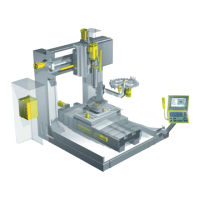21 – 358 HEIDENHAIN Service Manual iTNC 530 HSCI
21.2.8 Speed adjustment at the servo amplifier (tachometer adjustment)
You should adjust the speed at the servo amplifier, if ...
You have updated the mechanics of the axis
(guideways, bearings, belts, coupling, ball screw, etc.)
You have exchanged the analog servo amplifier or the motor.
You have replaced the carbon brushes.
The servo lag is impermissibly high at constant traverse.
The aim of speed adjustment is to achieve that the output nominal speed value is equal to the really
measured actual speed value (v nom = v act).
Suggestion for
performing the
adjustment
Below you find a proposal:
8 Set the machine parameter as follows (note down its original value):
• MP7290.x (display step): 6 (0.1 µm)
8 In the machine parameters MP1391.x and MP1392.x you can see whether the axis is operated with
following error or feedforward control.
8 Switch the position display to LAG.
8 Enter the following test program (e.g. for the X axis; choose a larger traverse range if possible and
select a speed that fits your machine):
8 Set the feed rate potentiometer to zero.
8 Run the program in the Program Run, Full Sequence operating mode and slowly turn the feed rate
potentiometer to 100 %.
This adjustment is only necessary for analog axes!
Before speed adjustment, the offset adjustment for the axis concerned should be performed.
--> See ”Adjusting the electrical offset (drift adjustment)” on page 21 – 355.
Analog servo amplifiers are not HEIDENHAIN products.
Follow the instructions of the servo manufacturer (operating instructions, etc.)!
0 BEGIN PGM tacho_adjustment X MM
1 LBL 1
2 L X+ 0 F 5000
3 L X + 300 F 5000
4 CALL LBL 1 REP 100
5 END PGM tacho_adjustment X MM
Enter this test program together with the machine operator. Take care that there is no collision
(retract Z axis first, etc.)!

